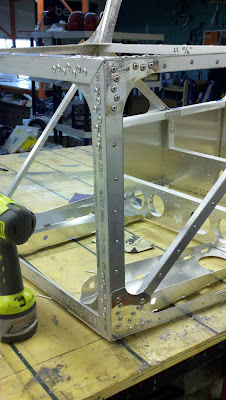Please note: James' blog has moved to a Wordpress site. To access it, please visit
http://jameswiebe.wordpress.com/. All posts have been transferred to the new site, and all new posts will only be accessible via Wordpress. Thank you for your interest!
We've been working on our carbon fiber processes... and in anticipation of some absolutely crazy stuff in 2013 (EG, an amphibious version of a Belite, for which we already have a firm order with deposit), some additional weight savings are necessarily on the development plate to accommodate the big amphibious floats in a legal Part 103 Belite ultralight aircraft.
So here's a sneek photo of Belite R&D: a carbon fiber stabilator (combination elevator / horizontal stabilizer).
 |
| Carbon Fiber Stabilator, Lucky and Chance check it out |
The important technical factors are:
Span: about 100 inches (2.54 meters)
Chord: 30 inches
Effective area: 19.16 square feet (about 1.78 square meters)
Construction: Carbon Fiber
Weight, as pictured: about 4 pounds
Target weight, completed assembly with covering: about 5.5 pounds (2.5 KG)
Airfoil: NACA 0012, symmetrical
Target load capability: approximately 240 pounds lift, representing full control deflection at yellow line speed (62mph)
(all information subject to change)
Benefits:
* Reduced drag - elimination of stabilizer support wires; lower coefficient of drag in cruise
* Reduced weight -- should save around 6 pounds (2.7KG)
* Better authority on takeoff roll (get the tail up faster) and better authority on landing (better flare at lower speeds, allowing safer landings and lower speeds)
Downsides:
* Expense of carbon fiber
* Engineering time
* Risk in testing
All the parts in the photo were designed on our CAD software and 'printed' on one of our CNC machines, the ShopBot. We also manufactured our own carbon fiber panels, which were cut on the ShopBot in the various shapes. We purchase the carbon fiber spars from a vendor.
The carbon fiber panels technical specs are as follows:
3K woven fiber, one layer each side
1/8" wood core
West Systems epoxy
Vaccuum bagged on glass
The final thought to chew on: each carbon fiber rib weighs about 2.1 ounces... that's 60 grams.





















































